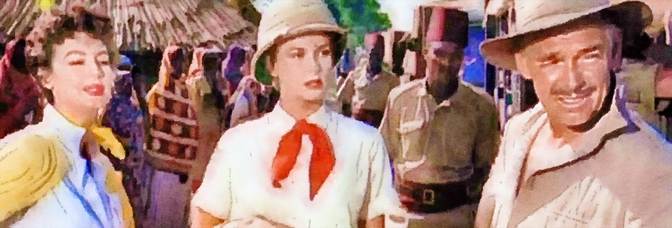John Ford not only goes to Africa, he also goes contemporary. Ford rarely directed anything but period pieces–as Westerns do fit under that umbrella–and it’s interesting to see how he handles it. I have to wonder if Mogambo was MGM’s response to The African Queen’s success. While the film does contain some of Ford’s best character work–small moments, like the discovery of the love triangle–it’s not an on-location African adventure. It’s a Hollywood film using African locations instead of backdrops. The result is disorientating, but also interesting. The colors are sumptuous, the general green of the African foliage and the cloud-filled blue skies; it’s completely different looking than any other Ford film. In fact, it looks a lot like The African Queen. I’m sure Mogambo is lifted that style, but it doesn’t make the film any less beautiful.
I’ve seen Red Dust, the source for the film, adapted by the same writer (John Lee Mahin) and also starring Clark Gable, but I don’t remember much about it. For example, I don’t remember if Gable’s the protagonist in Red Dust. In Mogambo, he and Grace Kelly’s love affair (Kelly is married to Gable’s client) is a subject the film documents, never personifies. The film only looks at them, never puts itself in Gable’s–or Kelly’s–position. Instead, the film is really Ava Gardner’s show. I’ve seen Gardner in a few films, but she’s fantastic in Mogambo, though the character is well-handled through the whole film. She gets to play with baby elephants, gets to feed baby rhinos… Grace Kelly runs and screams at the sign of any wildlife, no matter how cute. Obviously, the audience is supposed to side with Gardner–the film even gives her an unnecessary sob story to further curry favor.
Gable’s fine throughout, though he looks out of place at the end, when the film has to wrap up tidily. The film also looks out of place, since it mixes naturally-lighted footage of gorillas with the actors on a set. It doesn’t work at all; there’s no energy in the gorilla shots and so Ford gives no energy to the cut-away shots of the actors. Worse, even when there aren’t gorillas around, studio shots mix in with location footage, removing the Hollywood realism aura–awkward as it was–the film created for ninety-five minutes. The film worked its best in the first half, before the location-filled safari, where Ford had something different to do–not just get a film shot–and Gardner wasn’t just popping up in a different outfit each scene (she does have a lot of bags, but it seems unlikely she’d wear a sweater during the day in equatorial Africa). Grace Kelly is good in the beginning too, holding her own against Gable in one scene, then flattens for the rest.
All Mogambo needed was some more thought put into it, which makes its faults incredibly frustrating. Still, it’s worth seeing just for Ford’s work in the first half and Gardner’s throughout, even when she is wearing those ludicrous outfits. Warner’s DVD is excellent, but the print is so clean, it just makes the quality differences in film stock at end (again with the gorillas) more visible.

Leave a Reply